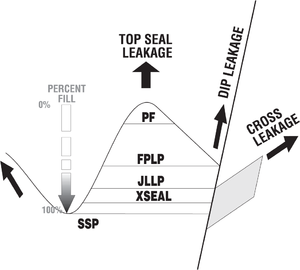Percent fill: controlling factors
| Exploring for Oil and Gas Traps | |

| |
| Series | Treatise in Petroleum Geology |
|---|---|
| Part | Predicting the occurrence of oil and gas traps |
| Chapter | Evaluating top and fault seal |
| Author | Grant M. Skerlec |
| Link | Web page |
| Store | AAPG Store |
The percent fill of a trap is the percentage of the trap volume filled with hydrocarbons compared with its total volume. Percent fill can be controlled by a number of factors, including the following:
- Top seal capacity/integrity
- Synclinal spill points
- Charge
- Fault seal capacity
- Fault-dependent leak points
Control summary
Figure 1 summarizes the various controls on percent fill and hydrocarbon column height. The maximum fill case is the synclinal spill point (SSP). A cross-leaking fault limits the percent fill to the juxtaposed lithology leak point (JLLP). A dip-leaking fault limits the percent fill to the fault plane leak point (FPLP).
A cross-sealing fault allows fill below the JLLP and possibly as deep as the SSP. A trap also may be partially filled (PF) due to either charge or top seal capacity. A partially filled trap can have a hydrocarbon contact at any depth.
Finite seal capacity of faults
Sealing faults may have some finite seal capacity. A fault may be able to support the pressure exerted by a 50-m hydrocarbon column but leak if the column increases to length::51 m.[1] Recent work suggests there may be a maximum seal capacity related to the percentage of shale in the fault gouge.[2][3] In most cases, however, the percent fill is significantly less and is limited by fault-dependent leak points rather than the seal capacity of the gouge.
See also
References
- ↑ Chong, K. P., P. M. Hoyt, J. W. Smith, and B. Y. Paulsen, 1980, Effects of strain rate on oil shale fracturing: International Journal of Rock Mechanics, vol. 17, no. 1, p. 35–43., 10., 1016/0148-9062(80)90004-2
- ↑ Yielding, G., B. Freeman, and D. T. Needham, 1997, Quantitative fault seal prediction: AAPG Bulletin, vol. 81, no. 6, p. 897–917.
- ↑ Skerlec, G. M., 1997, Atlas of fault seal behavior in the Gulf Coast: Franklin, Pennsylvania, SEALS International, 4356 p.
